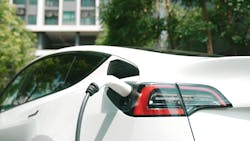Why Buildings Fall Short on EV Charging While Home Demand Surges
Electric vehicle (EV) adoption is skyrocketing despite tales of falling demand. By 2030, EV sales will reach almost 45 million and are expected to reach close to 65 million in 2035.
Transitioning to EVs is a positive step toward sustainability, but there’s a significant bottleneck: drivers face challenges charging where they need to most, at home. An NMHC survey revealed that 83% of EV owners prefer to charge at home. However, for those living in multifamily dwellings—apartments, condos, and townhomes, which account for 31.4% of all U.S. housing—there is a lack of EV equity and significant friction in their EV charging experience.
The Problem for Property Owners
Unlike single-family home residents, who can charge their vehicles without hassle, multifamily dwellers rely on their property owners to provide EV charging stations. To outfit a multifamily property with adequate EV charging capabilities, property owners face several challenges:
- High Capital Costs: The initial installation of EV charging infrastructure is expensive. Up to $7,000 can be spent on installing a single charging station, which includes hardware, electrical work, and labor. This high upfront investment is a significant deterrent for property owners who want to keep CapEx low.
- Limited Panel Capacity: Many buildings, especially older ones, need the electrical panel capacity to support multiple high-power chargers. Upgrading the electrical infrastructure to support standard EV charging stations can be complex and expensive.
- Poor Energy Efficiency: Standard EV chargers are not designed for multifamily properties and, therefore, utilize energy poorly and inefficiently. This inefficiency strains the building’s power supply, requiring costly upgrades to the electrical system to accommodate the additional load.
- Network Infrastructure Costs: Many EV chargers rely on cellular or WiFi networks to manage charging sessions, which adds to the infrastructure costs. Ensuring reliable network connectivity can be challenging and expensive, particularly in sub-basement or remote parking areas.
- Ongoing Maintenance: EV chargers require regular maintenance to remain operational. This includes software updates, hardware repairs, and potential replacement of faulty equipment. The ongoing maintenance cost adds another layer of financial burden for property managers.
- Regulation and Compliance: New building codes often require EV charging capabilities, adding regulatory pressure. Complying with these regulations while being cost-effective and energy-efficient is challenging for developers.
- Space Constraints: In densely populated urban areas, space for installing EV chargers can be limited. Parking lots or garages may need more physical space to accommodate the standard charging stations required to support residents' charging needs.
Current Chargers Don’t Support Driver Behavior
Convenience: Drivers want the convenience of charging their EVs at home just like they charge their phones. They expect to get home, plug in their EV, start the charge session, and get on with their lives. However, this is far from the reality for multifamily home residents. These properties often have only one or two standard charging stations, which must be increased to meet the demand.
EV musical chairs: This shortage of chargers forces residents to play a frustrating game of musical cars. They frequently have to interrupt their dinner or sleep to move their vehicles to allow another resident to use the charger. Also, many apartments impose idle fees ranging from $20 to $50 if residents leave their cars idle at the charging station after charging is complete.
Broken cables: Standard charging stations also come with cables that are prone to breaking. When these cables break, it can take days or weeks for the EV charging company to send a maintenance crew to fix or replace them. Additionally, many EV charging companies charge a monthly fee for using a charger, regardless of usage. Residents who are on vacation or not driving much still have to pay the recurring monthly fee.
EV Charging Infrastructure: What Building Owners Need to Know
The rapid adoption of electric vehicles is putting unprecedented strain on our electrical grid, which has yet to see significant innovation since Edison's time. As we move towards greater EV adoption, the way we charge our electric vehicles needs to evolve significantly.
Here are a few key considerations building owners should be aware of when thinking about adopting EV charging for their premises:
- Understand the Capital Costs: Installing EV chargers in multifamily buildings can be a significant investment, with an average capital cost of around $7,000 per charger. Building owners should explore innovative solutions to reduce these costs, such as bulk purchasing or leveraging government incentives, to make EV charging more financially viable.
- Focus on Right-Sized Charging: Fast charging options may not be feasible for all buildings due to grid limitations. Instead, building owners should consider the daily charging needs of their residents. For example, a typical 40-mile commute can be charged in about three hours using a standard 240V outlet. This approach can help optimize energy usage and reduce infrastructure strain.
- Navigate Regulatory Challenges: Understanding the regulatory landscape is crucial for building owners. EU and US regulations, such as NEC policy and charging requirements, can impact the implementation of EV charging stations. Staying informed about regulatory changes and advocating for more flexible policies can help building owners overcome these hurdles.
- Rethink Network Architecture: The current OCPP (Open Charge Point Protocol) connectivity policy is only 80% reliable, with no means to fix it when issues arise. Building owners should consider exploring alternative protocols and solutions that offer more reliable connectivity. The industry should advocate for rethinking the software architecture of EV charging systems to ensure more dependable charge sessions for end users.
The Future: Closing the Gap
The surge in electric vehicle adoption reveals a critical shortfall in at-home charging infrastructure, particularly in multifamily buildings. Addressing the challenges of high costs, limited energy capacity, ongoing maintenance, and regulatory compliance is absolutely critical to meeting the growing demand for multifamily residential EV charging solutions in an energy efficient way.
About the Author
Nicholas Johnson
Nicholas Johnson is the CEO and founder of Orange Charger.
